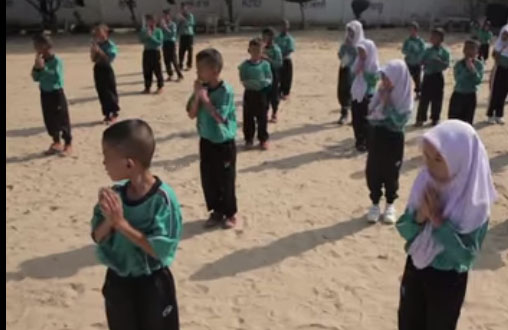The Norwegian government’s leadership to promote international standards to protect schools and universities from military use during armed conflict could spare students and teachers the horrors of war, the Global Coalition to Protect Education from Attack said today. Countries around the globe should work with Norway to support this initiative, the Global Coalition said. Norway’s announcement on June 13, 2014, was contained in its new white paper on global education.
The Global Coalition to Protect Education from Attack (GCPEA) consists of international organizations, including CARA (Council for At-Risk Academics), Human Rights Watch, the Institute of International Education’s Scholar Rescue Fund, the Norwegian Refugee Council, Protect Education in Insecurity and Conflict, Save the Children International, the Scholars at Risk Network, the United Nations Educational, Scientific and Cultural Organization (UNESCO), the United Nations Refugee Agency (UNHCR), and UNICEF.
“Armies and armed groups are turning places of learning into battlefields by using them for military purposes,” said Bede Sheppard, deputy children’s rights director at Human Rights Watch and chair of GCPEA’s working group on protecting schools and universities from military use. “Countless students stand to benefit from a safer education thanks to Norway’s efforts to secure better protection for schools from military use.”
In most countries with armed conflicts around the world, national armed forces and armed groups have used schools for military purposes, with devastating consequences for children and their right to education. Forces have converted schools into defensive positions, barracks, detention facilities, military training camps, weapons depots, and bases for military operations. Forces often take over only part of a school, putting students attempting to continue their studies potentially in the line of fire. Military deployments also expose students to sexual violence, forced labor, and forcible recruitment by the soldiers sharing their schools.
Since 2005, armed forces or armed groups have used schools in at least 24 countries in conflicts across Africa, Asia, Europe, the Middle East, and South America. Children and teachers have been injured and killed, and schools destroyed or damaged, when forces have attacked schools because opposing forces were using them. Other consequences of the military use of schools include long-term school closures, declines in student attendance and enrollment, and psychosocial harm to students, teachers, and communities. Military use of schools has an especially negative effect on education for girls, as many parents withdraw their daughters from occupied schools fearing the risk of sexual harassment or abuse.
To mark Norway’s announcement, GCPEA and Human Rights Watch released a Norwegian-language video depicting the negative impact of military use of schools on children. The video includes photos and footage obtained by Human Rights Watch researchers during their investigations, as well as by Magnum and Getty Images photographers working for Human Rights Watch. The video also contains archive footage of Malala Yousafzai, the teenager who was shot and seriously wounded by the Taliban for advocating education for girls in Pakistan, inspecting a school that had been run by her father. The family discovered that it had been occupied and used by the Pakistan military during the Yousafzai family’s exile from the Swat Valley.
Norway has proposed leading a process to finalize what are currently known as the Draft Lucens Guidelines for Protecting Schools and Universities from Military Use. These draft guidelines were developed in consultation with experts from the ministries of foreign affairs, defense, education, and armed forces of 12 countries from each region of the world. The Draft Lucens Guidelines draw from existing international laws of war, international human rights law, and examples of good practices from military forces around the world.
“Norway’s commitment to championing the Guidelines represents a milestone in the journey towards securing safe learning environments for all students, including those most at risk of being denied their right to education: children and young people living in war zones across our globe,” said Diya Nijhowne, GCPEA director.
The Guidelines urge parties to armed conflict not to use schools and universities for any purpose in support of the military effort. All parties to armed conflict should endeavor to avoid impinging on students’ safety and education, using the Guidelines as a guide to responsible practice. Countries will be asked to publicly endorse the finalized guidelines, and pledge to implement them into their domestic military doctrine, manuals, and training.
Students and educators who wish to add their voice to support the end of military use of schools can contribute photos and slogans to the website EMUScampaign.org.
“Schools should be filled with students, not soldiers,” Sheppard said. “Norway’s leadership to protect schools from military use sends a clear message that it’s time we give schools back to the students.”
For more information, please see:
- “From Sagene to Sanaa,” by Bede Sheppard, originally published in Dagsavisen: http://www.hrw.org/news/2013/10/07/sagene-sanaa
- Lessons in War: Military Use of Schools and Other Education Institutions during Conflict, from the Global Coalition to Protect Education from Attack, 2012: http://protectingeducation.org/sites/default/files/documents/lessons_in_war.pdf
- Education under Attack 2014, “Military use of schools and universities: changing behavior,” from the Global Coalition to Protect Education from Attack: http://protectingeducation.org/sites/default/files/attachments/eua_2014_thematic_essay_military_use.pdf
- “Safe No More: Students and Schools under Attack in Syria,” Human Rights Watch, June 2013: http://www.hrw.org/news/2013/06/05/syria-attacks-schools-endanger-students
- Attacks on Education: The Impact of Conflict and Grave Violations on Children’s Futures, Save the Children, 2013: http://protectingeducation.org/sites/default/files/documents/grave_violations.pdf
- Childhood under Fire: The Impact of Two Years of War in Syria, Save the Children, 2013: http://protectingeducation.org/sites/default/files/documents/childhood_under_fire_embargoed_until_13th_march.pdf
- Protecting Education in Insecurity and Armed Conflict: An International Law Handbook, Education Above All: http://www.protectingeducation.org/sites/default/files/documents/eaa_protecting_education_in_insecurity.pdf
- “Classrooms in the Crosshairs: Military Use of Schools in Yemen’s Capital,” Human Rights Watch, September 2012: http://www.hrw.org/reports/2012/09/11/classrooms-crosshairs






